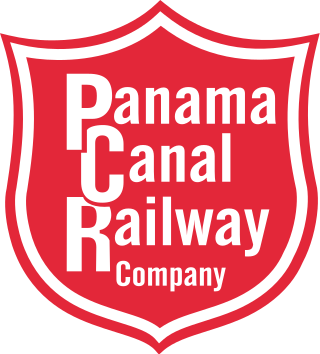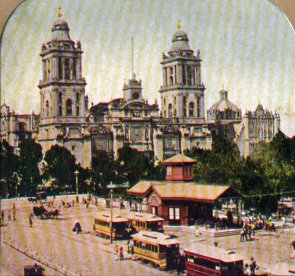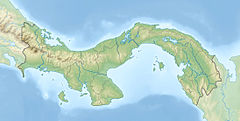
A tram is a type of urban rail transit consisting of either individual railcars or self-propelled multiple unit trains that run on tramway tracks on urban public streets; some include segments on segregated right-of-way. The tramlines or tram networks operated as public transport are called tramways or simply trams/streetcars. Due to their close similarities, trams are commonly included in the wider term light rail, which also includes systems separated from other traffic.

The Panama Canal Railway is a railway line linking the Atlantic Ocean to the Pacific Ocean in Central America. The route stretches 47.6 miles (76.6 km) across the Isthmus of Panama from Colón (Atlantic) to Balboa. Because of the difficult physical conditions of the route and state of technology, the construction was renowned as an international engineering achievement, one that cost US$8 million and the lives of an estimated 5,000 to 10,000 workers. Opened in 1855, the railway preceded the Panama Canal by half a century; the railway was vital in assisting the construction of the canal in the early 1900s. With the opening of the canal, the railroad's route was changed as a result of the creation of Gatun Lake, which flooded part of the original route. Following World War II, the railroad's importance declined and much of it fell into a state of neglect until 1998, when a project to rebuild the railroad to haul intermodal traffic began; the new railroad opened in 2001.

A tram-train is a type of light rail vehicle that both meets the standards of a light rail system, and also national mainline standards. Tramcars are adapted to be capable of running on streets like an urban tramway but also be permitted operation alongside mainline trains. This allows services that can utilise both existing urban light rail systems and mainline railway networks and stations. It combines the urban accessibility of a tram or light rail with a mainline train's greater speed in the suburbs.

Line A is the oldest line of the Buenos Aires Underground. Opened to the public on 1 December 1913, it was the first underground line in South America, the Southern Hemisphere and the Spanish-speaking world. It made Buenos Aires the 13th city in the world to have an underground transport service. The line stretches 9.8 km (6.1 mi) from Plaza de Mayo and San Pedrito and runs under the full length of the Avenida de Mayo and part of the Avenida Rivadavia, and is used by 258,000 people per day.
Trams in India were established in the late 19th century. Horse-drawn trams were introduced in Kolkata in 1873; in Mumbai, trams began operations in 1874; in Nashik in 1889; electric trams began in Chennai in 1895, and trams were also introduced in Kanpur and Delhi. They were discontinued in all Indian cities between 1933 and 1964, except for Kolkata.

Stadtbahn is a German word referring to various types of urban rail transport. One type of transport originated in the 19th century, firstly in Berlin and followed by Vienna, where rail routes were created that could be used independently from other traffic.
Since 2008, there was only one functioning railroad in Panama, a number that increased to two in 2014 with the opening of the Panama Metro. The first one was the Panama Canal Railway, operated by the Panama Canal Railway Company, successor of Panama Railway, which provides passenger and freight service between Panama City and Colón. In 2014, Panama Metro started operation. Historically, there were also narrow gauge railroads in Chiriquí Province, which were abandoned in the late 20th century.

Until 1958, trams formed a network spanning most of Adelaide, South Australia, with a history dating back to 1878. Adelaide ran horse trams from 1878 to 1914 and electric trams from 1909, but has primarily relied on buses for public transport since the mid-20th century. Electric trams, and later trolleybuses, were Adelaide's main method of public transport throughout the life of the electric tram network. The tram network was progressively closed down through the 1950s with the last lines closing in 1958; the Glenelg tram line was the only line to survive these closures and has remained in operation ever since and has been progressively upgraded and extended since 2005.

Rail transport in Central America consists of several isolated railroad lines with freight or passenger service. The most famous one is the Panama Canal Railway, the oldest transcontinental railroad in the world, connecting Panama City with Colón since 1855. Other railroads in Belize, Guatemala, Honduras, El Salvador, Nicaragua, Costa Rica and Panama were built by private and public investors mainly to facilitate the transport of local agricultural produce to export markets and harbors. Their market share and profitability went into decline in the second half of the twentieth century and most lines have been decommissioned by the end of the 1990s. As of 2018, railroads operate locally in Honduras, Costa Rica and Panama only; all rail transport has been suspended in Belize, El Salvador, Guatemala and Nicaragua. The railways still operating do not cross national borders.

Trams in Bogotá were first inaugurated on December 24, 1884 with the first tramway pulled by mules, covering the route from Plaza de Bolívar to San Diego, in Bogotá, Colombia. In 1892, a tramline linking Plaza de Bolívar and Estación de la Sabana started operating. The original trams ran over wooden rails but since such tramways easily derailed, steel rails imported from England were later installed. In 1894, a tramcar ran on the Estación de la Sabana to Chapinero line every twenty minutes.

Although tram and Heritage streetcar systems date to the late 19th and early 20th centuries, many old systems were closed during the mid-20th century because of the advent of automobile travel. This was especially the case in North America, but postwar reductions and shutdowns also occurred on British, French and other Western European urban rail networks. However, traditional tramway systems survived, and eventually even began to thrive from the late 20th century onward, some eventually operating as much as when they were first built over a century ago. Their numbers have been augmented by modern tramway or light rail systems in cities which had discarded this form of transport.

The Premetro is a 7.4-kilometer long (4.6 mi) light rail line that runs along the outskirts of Buenos Aires, connecting with the Buenos Aires Underground line E, at Plaza de los Virreyes station and then to General Savio, with a short branch to Centro Cívico. It opened in 1987 and is operated by Metrovías. Originally, the Premetro was to include many more lines, but shortly after the privatisation of the railways the projects were postponed and never materialised and only "Premetro E2" was built.

The Bogotá Savannah Railway was a company that provided transport for passengers from 1889 between the cities of the Metropolitan Area of Bogotá. The Savannah railway was liquidated in 1991 along with the National Railways of Colombia.

The Bogotá suburban rail, also known as RegioTram, is a transportation project to create a mass and rapid transport system to connect Bogotá with surrounding cities. The railways of the former Bogotá Savannah Railway will be rebuilt to create a new tram-train network. Three lines are planned, to the West, North and South of Bogotá.

Mexico City once had an extensive network of streetcars. Most streetcar lines in Mexico City radiated from the city's central square, the Zócalo towards many parts of the city. By the 1980s only one streetcar line survived, which itself was converted into the Xochimilco Light Rail line in 1986.

The first trams in Buenos Aires began operating in 1863 in what quickly became a vast network of tramways with the city being known as the "City of Trams" for having the highest tramway-to-population ratio in the world. In the 1920s, Buenos Aires had 875 km (544 mi) of tramways and 99 tram lines using 3000 carriages running throughout the city. By 1963, the vast majority of the network began to be dismantled, though some minor tram services continue in the city today.

The Ayacucho Tram is a Translohr tram system that serves the Metropolitan Area of the Aburrá Valley in Medellín, Antioquia, Colombia. It started trial operations on 20 October 2015. The tramline consists of 9 stations with three of those allowing interchanges with the Medellín Metro and the Metrocable systems. The Ayacucho Tram is operated by Medellín Metro and is the only tram in Colombia.

The Murcia tram is a tram/light rail system operational in the Spanish city of Murcia. The 17.5 km (10.9 mi) system opened in 2011 and links the city centre with the northern suburbs.

















